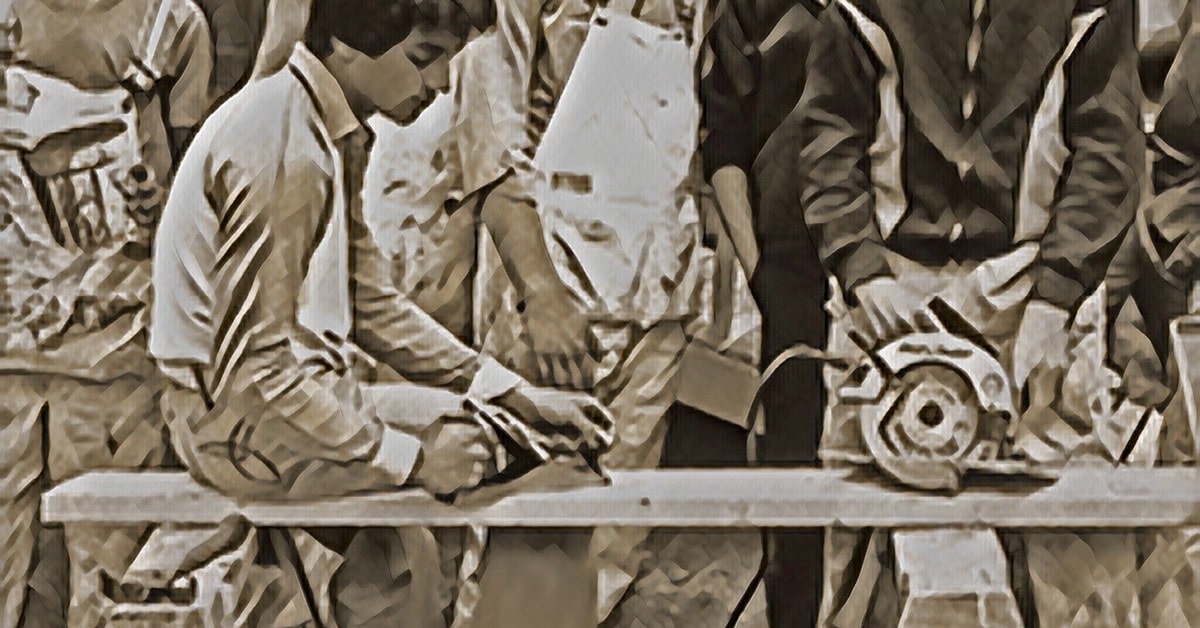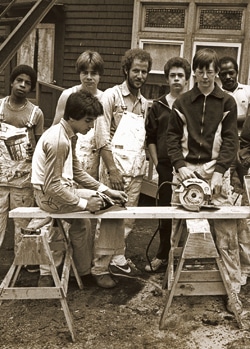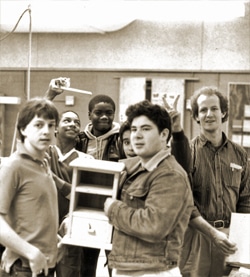
 I used to think that traditional public education was the institution with the most promise for developing social equality in the United States.
I used to think that traditional public education was the institution with the most promise for developing social equality in the United States.
I first taught when I became a carpentry teacher for inner city students at the height of the desegregation struggles in the 1970s in Boston. At the time, I thought that traditional public education was the best vehicle for rising people out of social disadvantage, and for solving some of the most egregious forms of segregation by class and race in our society. Having just been in law school, I realized the very first day of teaching these working class kids (who affectionately called themselves “knuckleheads”) that they were every bit as bright as the middle class “kids” I was with in law school. This realization has driven my work ever since. I thought we could provide these Boston kids the same outcomes as the middle class law school students if only we could engage their natural intelligence, develop their skills, and help them set their sights higher.
As a union building representative and a member of my local’s executive committee, I used to think that collective bargaining could empower us to become better teachers and transform our schools.
As a former tenant organizer, I thought that elected school boards were an important part of local democracy, giving voice to low-income and unrepresented parents and community members. I thought local school boards could be an effective vehicle for democratic participation in, and transformation of, the precious institution of public schooling.
And then I saw…
And then I saw that public schools were part and parcel of the social injustice I was hoping to change. At best our schools perpetuated race and class inequality. At worst, they promoted it, by tracking students by “ability” and “vocation,” which in truth were a proxy for their skin color and the education level of their parents. Even in schools that were diverse as a whole (which were becoming fewer and fewer), once inside the school doors, students of different races and class backgrounds had profoundly segregated experiences. The lawyers’ and professors’ sons and daughters took the honors and AP classes with each other, while the working class kids came to me in “voc ed.”
I saw that teachers unions, administrators, parents, and school boards were locked in a bureaucratic stasis of self-interest. It is a dysfunctional stasis, yet in perfect equilibrium, and is therefore very difficult to dislodge. The unions had taken a path of “pulling up the ladder”: protecting those with the most seniority, without regard to commitment, creativity, teaching ability or any of a host of other values that are more important to children’s happiness and learning. The union also defined its role as the defender of job security for any and all teachers, regardless of whether they were detrimental to students or otherwise ill-suited to teaching.
I saw that teachers who were used to teaching a narrow band of students – either the AP or remedial stripe – were not interested in stretching themselves to teach fully integrated groups of students who would require a widely differentiated curriculum. Even in our own progressive charter middle and high schools, which purportedly attract students because of their diversity and alternative pedagogy, we experience pressure from parents to separate out the “advanced” students. At one point early in our history, some of our teachers wanted to break our math classes into several tracks. We projected out what would happen to class groupings and schedules, and we realized we would soon have our own internally segregated schools if we took that path. So, we did not, and still do not, segregate students – at all.
In my first month as a school principal in a large traditional urban high school, a school board member tried to muscle me into filling my first new teacher hiring with one of his friends. I resisted, as hiring excellent teachers is one of a principal’s most important tasks. That school board member then proceeded to try to block everything, large and small, that I had before the school board. I do not usually subscribe to policy by anecdote, but I think that experience is not an isolated one, and many school board members use their role as patronage vehicles. Elected school boards are rare in most industrialized countries and present an odd combination in this one. They offer an illusion of democratic participation, but do not really provide it. They are very rarely able to generate substantial reform, but are able to prevent it. What they can do is control minutia and thus often become absorbed in micromanagement.
And Now I See…
That my dreams about public education can indeed come true, if schools, teachers and students are able to break out of the bureaucratic constraints that are smothering most public schools. There are small, integrated schools all over the country – many of them are charter schools, others are within districts and have negotiated the freedoms necessary to hire their own teachers and empower them to be co-creators of schools.
 I have visited many schools in many states over the last three decades. I almost universally find that in small independent schools, whether privates, pilots, or public charters, the teachers have far more control of their work than teachers do under collective bargaining agreements.
I have visited many schools in many states over the last three decades. I almost universally find that in small independent schools, whether privates, pilots, or public charters, the teachers have far more control of their work than teachers do under collective bargaining agreements.
I have seen more authentic assessment in such schools than in traditional district schools. I have been to evening exhibitions of student work in these schools where the building is packed with parents, grandparents, siblings and cousins because the students have told them all, “you must come see what I did.” This is a form of transparency of what students and teachers are up to that gives new meaning to public participation. This is a different way to have strong community engagement – inviting the community into schools on a regular basis to see students present their work. Another powerful method is the internship, in which students engage in real work and real learning alongside a mentor in the community, and are not isolated from the adult world they are preparing to enter.
It is possible to have choice with diversity. A non-meritocratic, zip code based lottery randomly selects students in a way that insures diversity. Coupled with no ability grouping within the school, one can find schools that are both diverse – and integrated.
And now I work in a setting that has a Graduate School of Education fully immersed in our K-12 public charter schools. Adult learning is integrated with student learning in a community of learners. It involves planning and executing differentiated instruction for diverse students in an integrated setting. It is founded on an integration of “head and hand” – a marriage of the pursuit of literacy and numeracy through a constructivist, applied, expeditionary pedagogy.
Now I see K-12 schools coupled with adult graduate school learning imbedded within a conceptual framework of inquiry and design, leadership, and reflective practice. This is the democratic schooling I have longed for. It can happen.

 I used to think that traditional public education was the institution with the most promise for developing social equality in the United States.
I used to think that traditional public education was the institution with the most promise for developing social equality in the United States.
I first taught when I became a carpentry teacher for inner city students at the height of the desegregation struggles in the 1970s in Boston. At the time, I thought that traditional public education was the best vehicle for rising people out of social disadvantage, and for solving some of the most egregious forms of segregation by class and race in our society. Having just been in law school, I realized the very first day of teaching these working class kids (who affectionately called themselves “knuckleheads”) that they were every bit as bright as the middle class “kids” I was with in law school. This realization has driven my work ever since. I thought we could provide these Boston kids the same outcomes as the middle class law school students if only we could engage their natural intelligence, develop their skills, and help them set their sights higher.
As a union building representative and a member of my local’s executive committee, I used to think that collective bargaining could empower us to become better teachers and transform our schools.
As a former tenant organizer, I thought that elected school boards were an important part of local democracy, giving voice to low-income and unrepresented parents and community members. I thought local school boards could be an effective vehicle for democratic participation in, and transformation of, the precious institution of public schooling.
And then I saw…
And then I saw that public schools were part and parcel of the social injustice I was hoping to change. At best our schools perpetuated race and class inequality. At worst, they promoted it, by tracking students by “ability” and “vocation,” which in truth were a proxy for their skin color and the education level of their parents. Even in schools that were diverse as a whole (which were becoming fewer and fewer), once inside the school doors, students of different races and class backgrounds had profoundly segregated experiences. The lawyers’ and professors’ sons and daughters took the honors and AP classes with each other, while the working class kids came to me in “voc ed.”
I saw that teachers unions, administrators, parents, and school boards were locked in a bureaucratic stasis of self-interest. It is a dysfunctional stasis, yet in perfect equilibrium, and is therefore very difficult to dislodge. The unions had taken a path of “pulling up the ladder”: protecting those with the most seniority, without regard to commitment, creativity, teaching ability or any of a host of other values that are more important to children’s happiness and learning. The union also defined its role as the defender of job security for any and all teachers, regardless of whether they were detrimental to students or otherwise ill-suited to teaching.
I saw that teachers who were used to teaching a narrow band of students – either the AP or remedial stripe – were not interested in stretching themselves to teach fully integrated groups of students who would require a widely differentiated curriculum. Even in our own progressive charter middle and high schools, which purportedly attract students because of their diversity and alternative pedagogy, we experience pressure from parents to separate out the “advanced” students. At one point early in our history, some of our teachers wanted to break our math classes into several tracks. We projected out what would happen to class groupings and schedules, and we realized we would soon have our own internally segregated schools if we took that path. So, we did not, and still do not, segregate students – at all.
In my first month as a school principal in a large traditional urban high school, a school board member tried to muscle me into filling my first new teacher hiring with one of his friends. I resisted, as hiring excellent teachers is one of a principal’s most important tasks. That school board member then proceeded to try to block everything, large and small, that I had before the school board. I do not usually subscribe to policy by anecdote, but I think that experience is not an isolated one, and many school board members use their role as patronage vehicles. Elected school boards are rare in most industrialized countries and present an odd combination in this one. They offer an illusion of democratic participation, but do not really provide it. They are very rarely able to generate substantial reform, but are able to prevent it. What they can do is control minutia and thus often become absorbed in micromanagement.
And Now I See…
That my dreams about public education can indeed come true, if schools, teachers and students are able to break out of the bureaucratic constraints that are smothering most public schools. There are small, integrated schools all over the country – many of them are charter schools, others are within districts and have negotiated the freedoms necessary to hire their own teachers and empower them to be co-creators of schools.
 I have visited many schools in many states over the last three decades. I almost universally find that in small independent schools, whether privates, pilots, or public charters, the teachers have far more control of their work than teachers do under collective bargaining agreements.
I have visited many schools in many states over the last three decades. I almost universally find that in small independent schools, whether privates, pilots, or public charters, the teachers have far more control of their work than teachers do under collective bargaining agreements.
I have seen more authentic assessment in such schools than in traditional district schools. I have been to evening exhibitions of student work in these schools where the building is packed with parents, grandparents, siblings and cousins because the students have told them all, “you must come see what I did.” This is a form of transparency of what students and teachers are up to that gives new meaning to public participation. This is a different way to have strong community engagement – inviting the community into schools on a regular basis to see students present their work. Another powerful method is the internship, in which students engage in real work and real learning alongside a mentor in the community, and are not isolated from the adult world they are preparing to enter.
It is possible to have choice with diversity. A non-meritocratic, zip code based lottery randomly selects students in a way that insures diversity. Coupled with no ability grouping within the school, one can find schools that are both diverse – and integrated.
And now I work in a setting that has a Graduate School of Education fully immersed in our K-12 public charter schools. Adult learning is integrated with student learning in a community of learners. It involves planning and executing differentiated instruction for diverse students in an integrated setting. It is founded on an integration of “head and hand” – a marriage of the pursuit of literacy and numeracy through a constructivist, applied, expeditionary pedagogy.
Now I see K-12 schools coupled with adult graduate school learning imbedded within a conceptual framework of inquiry and design, leadership, and reflective practice. This is the democratic schooling I have longed for. It can happen.